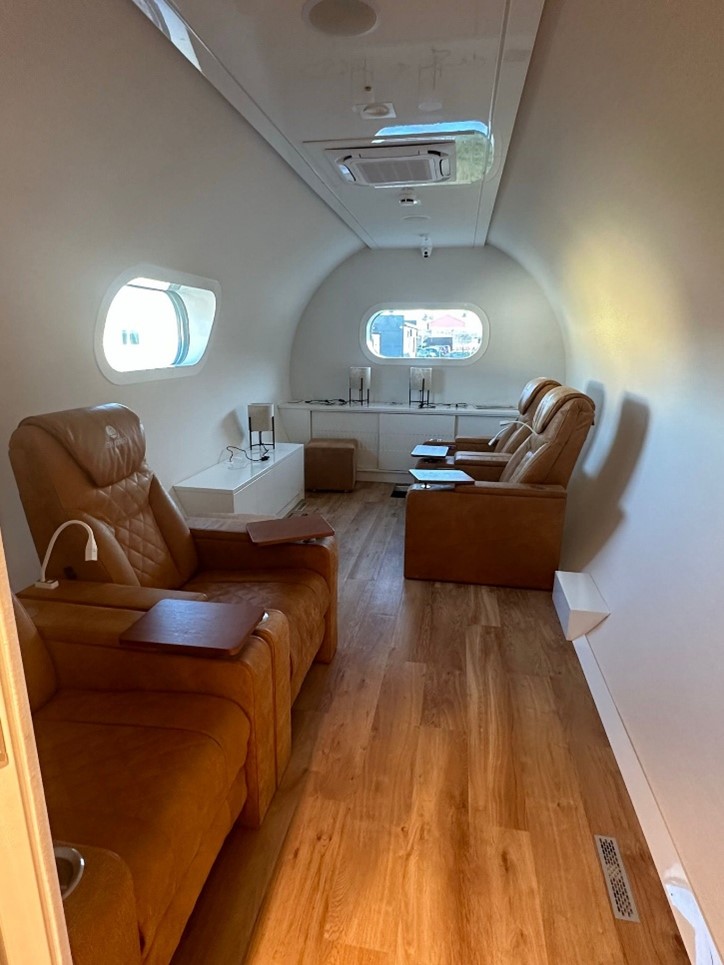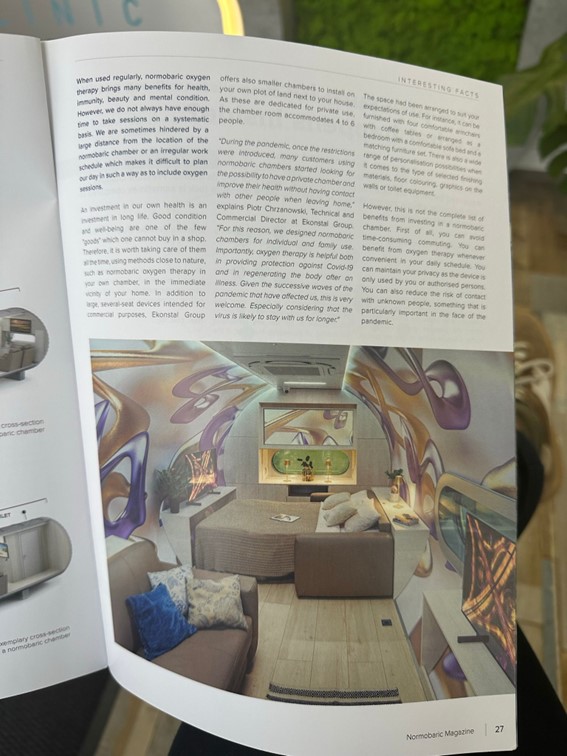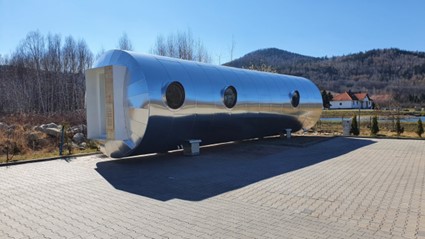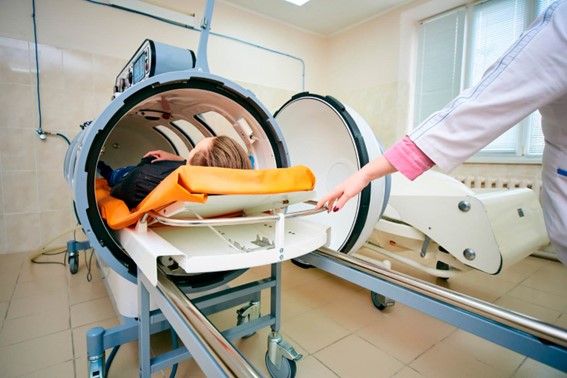
Compared to hyperbaric chambers, Normobaric therapy is not just oxygen therapy; it’s based on a synergistic effect of hydrogen, oxygen, and carbon dioxide, all combined in the right proportions, enhanced by increased atmospheric pressure. Normobaric sessions have a positive impact on beauty, physical condition, intellectual efficiency, and health in general. Treatments help to speed up the recovery process, accelerate regeneration, fight fatigue, and facilitate relaxation.
Research indicated that this kind of treatment can stimulate bone marrow to increase stem cell production up to eightfold. This is due to the proper oxidation of the bone marrow during one’s stay in the normobaric chamber. An increase in the generation of stem cells translates into faster renewal and regeneration processes in the body.
The first normobaric house was built in Poland in 2013. Doktor Pokrywka has lived inside it ever since. The atmospheric pressure on Earth is currently around 101.3 kilopascals (in other equivalent units, 14.7 psi or 1 ATA), not allowing complete tissue oxygenation. Recently, scientists have discovered that the regenerative processes of the body occur much more rapidly when under greater oxygen pressures. The increase in pressure allows for better oxygenation of all tissues and more efficient oxygen intake and usage. Also, carbon dioxide is needed to increase the effectiveness of oxygenation. After oxygen binds to hemoglobin in the lungs, carbon dioxide helps facilitate its release into the tissues and cells. This is known as the “Bohr effect.”

The carbon dioxide concentration directly relates to the effectiveness of this process, allowing hemoglobin to release oxygen more easily. Unfortunately, there is currently only 0.03% of carbon dioxide in the atmosphere (50 times too little for therapeutic effect). There is only 21% of oxygen in the atmosphere of Earth (not enough to absorb and fully oxygenate our cells), and in some places, less. In urban environments, confined spaces, or inflamed tissues, oxygen availability and delivery can drop far below optimal, leading to hypoxia, fatigue, and cellular dysfunction.
CO₂ is not just a “waste gas”—it’s a vital regulator
of respiration, pH, circulation, and oxygen delivery.
The solution is to raise oxygen concentration and slightly increase the concentration of carbon dioxide with minimal increase in air pressure. This way, Normobaric therapy (NBOHT) can provide safe, affordable, and relaxing oxygen therapy at a safe pressure with the comfort of space and no need to use any special masks.
Normobaria is a therapeutic environment developed primarily in Poland and now spreading across Europe. It involves breathing a carefully calibrated gas mixture in a sealed, softly pressurized space:
- Oxygen (O₂): 35% to 40%
- Carbon Dioxide (CO₂): 0.5% to 3%
- Hydrogen (H₂): 0.4% to 1%
- Pressure: ~1.5 atmospheres (approx. 1500 hPa)
I was amazed to stumble across this therapy, whose idea predated my publication of Hydrogen Medicine by four years. However, I started writing about carbon dioxide and oxygen over fifteen years ago and published books on each subject. It is more than pleasant to have such confirmation of my definition of Hydrogen Medicine, which is to combine these primary gases. I always say that the essence of the book is in the subtitle.

These chambers are designed to stimulate stem cell proliferation, enhance tissue oxygenation, improve circulation, reduce inflammation, and activate the body’s repair systems. Patients typically spend 1 to 2 hours per session in these environments, experiencing enhanced vitality, improved cognition, better sleep, and systemic regenerative effects.
The mixture and pressure are precisely tuned: elevated O₂ enhances diffusion; added CO₂ invokes the Bohr effect (improved oxygen unloading); and hydrogen serves as a selective antioxidant, mitigating oxidative stress without interfering with beneficial immune activation.
Point-by-Point Comparison
|
Element |
Normobaria Chamber |
My Protocols |
|---|---|---|
|
Oxygen |
35-40% external, under pressure |
Enhanced via slow breathing, magnesium, EWOT |
|
CO₂ |
0.5-3% in air (Bohr effect) |
Breath retraining, CO₂-rich baths, bicarbonate |
|
Hydrogen |
0.4-1% infused |
Molecular hydrogen inhalation |
|
Pressure |
1.5 atm in a sealed chamber |
Simulated via blood CO₂/O₂ shifts, EWOT |
|
Magnesium |
Not emphasized |
Central to my therapy |
|
Access/Cost |
Requires clinic, $$ |
Home-based, low-cost |
|
Philosophy |
External intervention |
Internal restoration |

Normobaria confirms what I have taught: health is a function of restoring the correct internal gases, minerals, and circulatory dynamics. The chambers are evidence that even high-tech approaches are returning to foundational principles. Yet my protocols remain more accessible and affordable in the long run.
As the natural cardiology revolution unfolds, a powerful convergence is emerging between ancient principles of internal balance and the newest developments in atmospheric medicine. What becomes clear is that both approaches converge on the same cellular truth: the human body thrives on subtle shifts in chemistry that restore coherence, flow, and regenerative potential.

My Protocols: Internal Normobaria Through Daily Practice
For over 20 years, I have taught protocols that achieve similar physiological ends without requiring a chamber. These include:
- Slow, deep nasal breathing to increase internal CO₂ and optimize O₂ delivery
- Hydrogen gas inhalation for mitochondrial protection
- Magnesium therapy to relax vascular tissue and enhance oxygen uptake
- Bicarbonate/CO₂ baths to alkalize the tissues and buffer metabolic stress
- High-dose iodine and selenium for metabolic and immune reactivation
- Conscious breathing and emotional presence to calm the autonomic nervous system
- Exercise With Oxygen Therapy (EWOT) to deliver a wall of oxygen during physical exertion, vastly increasing cardiac output and oxygen saturation
- Far Infrared Therapy
- Chlorine dioxide
- DMSO
- CO2 Inhalation
- Super Foods

More convenient than hyperbaric and more effective.

However, the science and research on hyperbaric treatments demonstrate the effectiveness of such therapies. A Swedish trial (phase II, double-blind) assessed 10 HBOT sessions versus sham in long COVID patients. While full results are pending, initial findings showed improvements in neurocognitive function, fatigue, and quality-of-life parameters.
A meta-analysis of three studies (195 patients) shows that HBOT post-revascularization raised ejection fraction (LVEF) by ~4.2% (95% CI 0.97–7.34, p = 0.01), indicating improved heart pump function after heart attacks.
A 2023 meta-analysis including nine trials (288 patients) found HBOT helped reduce chronic pain, improve sleep, functional capacity, and satisfaction. About 24% reported mild barotrauma (ear/lung pressure issues), but no serious adverse events were recorded.
According to a Cochrane review (August 2023), HBOT may help treat late radiation injuries in soft tissues and bone (e.g., head, neck, bowel), improving healing and reducing complications.
Dr.Sircus is a reader-supported publication. To receive new posts and support my work, consider becoming a free or paid subscriber.
Subscribe now




comments